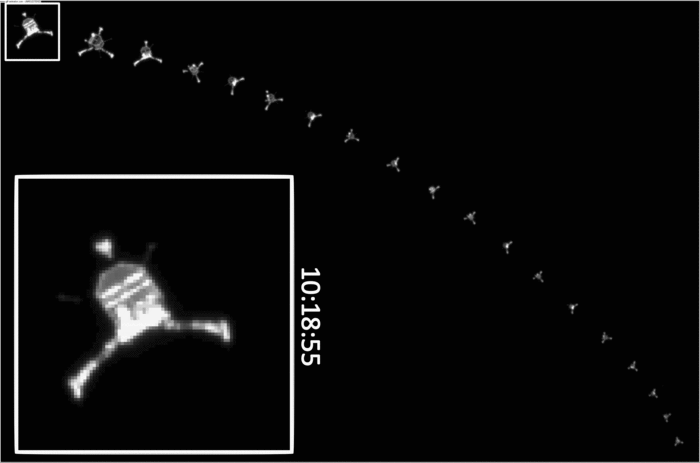ESA has published new photos of the landing of "Fila", which can help to find the device.
The agency showed how to search
 There are two main questions in the Rosetta mission: where the Phila probe is located, and when it will turn on again. The European Space Agency tried to answer in its blog. This post is interesting mainly three new images from the "Rosetta".
There are two main questions in the Rosetta mission: where the Phila probe is located, and when it will turn on again. The European Space Agency tried to answer in its blog. This post is interesting mainly three new images from the "Rosetta".On the left (the original by click) presents a previously unpublished photo obtained on November 12, 2014 at 17:18 GMT. The picture was posted on the ESA website only on January 30 of this year. The red lines highlight what, according to the OSIRIS team, is the Fila probe, which, for a little more than an hour before, first touched the surface of comet 67P / Churyumov-Gerasimenko. From this image of a barely noticeable point near the edge of a large depression, searches and reconstructions of the trajectory of the apparatus repel each other.
On November 12, the Filas made the first soft landing in the history of the comet's nucleus, and it ended unsuccessfully in a number of indicators. It is believed that the entire probe bounced off the surface three times. The CONSERT tool allowed us to identify the probable location area of the probe with a size of 350 × 30 meters, but so far it has not been possible to determine the exact location of the probe.
Below is an example of one of the images that are used to perform a manual visual search. The photo was obtained on December 13, 20 km from the center of the comet and published on the ESA website on January 30. The problem with such images is that a probe about the size of a household washing machine will only have three pixels on them. It has already been found several sets of points, similar to "Fila". A total of 18 pairs of images were taken from a distance of 20 km - one with blue and one with an orange light filter. This technique will help to better distinguish the solar panels of the probe.
')

Red highlighted the search area of the device "Fila". The original image is available by clicking.
On February 14 of this year, Rosetta will fly around a comet 6 kilometers from the surface, and the trajectory will be such that the Sun will be behind the vehicle, thereby avoiding unnecessary shadows. There will be no special changes to the orbit of rotation around the comet for searches, the images are obtained by combining several types of work scored for the months ahead of the Rosetta routine.
The blog also raised the question of the future work of the Fila apparatus. Nothing particularly new was said about the previous statements , the earliest possible inclusion date is late March, but most likely it will be May or June. To get out of sleep mode and exchange information with the "Rosetta" probe needs 17 watts. Now the device receives about 1.3 hours of sunlight for each rotation of the comet, and this is not enough.
Also among the images published on January 30, there is an animation of the descent of the probe to the comet surface on November 12, 2014. This is a series of 19 photos of the OSIRIS camera on the Rosette, the GMT timestamps correspond to the hours on board. By clicking the original animation available in size 2.38 MiB.

Source: https://habr.com/ru/post/376069/
All Articles